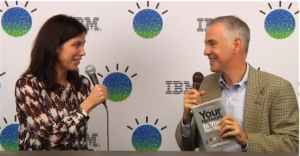 One of the reasons I love my career choice is that I get to meet so many clever people who bring fresh thinking to age old challenges. Porter Gale is one of those people, who’s four year tenure as CMO at Virgin America represented the triumph of the scrappy start-up over the intrenched Goliaths, rich with innovation from the seatbelt instructional video to the reservation system and multiple points in between. Having left Virgin, Porter Gale is sharing her some of things she’s learned via a new book, Your Network is Your Net Worth, a topic we discussed on video at the recent IBM Smarter Commerce Summit. Recognizing that most of you won’t want to devote 12 minutes to watching this video, here are the highlights of our conversation on the power of networks and how marketers big and small can capitalize on the growing importance of big data.
One of the reasons I love my career choice is that I get to meet so many clever people who bring fresh thinking to age old challenges. Porter Gale is one of those people, who’s four year tenure as CMO at Virgin America represented the triumph of the scrappy start-up over the intrenched Goliaths, rich with innovation from the seatbelt instructional video to the reservation system and multiple points in between. Having left Virgin, Porter Gale is sharing her some of things she’s learned via a new book, Your Network is Your Net Worth, a topic we discussed on video at the recent IBM Smarter Commerce Summit. Recognizing that most of you won’t want to devote 12 minutes to watching this video, here are the highlights of our conversation on the power of networks and how marketers big and small can capitalize on the growing importance of big data.
Drew Neisser: Tell me about your new book?
Porter Gale: It’s all about the power of connections and networks and it talks about how important our relationships are but there is also a lot of digital media strategy and conversation about how the world is changing because of social. So it is a fascinating book, lots of great interviews and my mom loved it and I hope that you will.
Drew Neisser: Talk to me a little bit about that how technology and social are coming together?
Porter Gale: Well, as you know I was with Virgin America for four years and so I think that is a great example of a company that has put digital in the forefront of their strategy. For Virgin, it is not only through the product experience (like WiFi on the planes), but also the whole marketing strategy is really focused on empowering the customer with digital. We’re talking to them through their [smart] phone, through their iPads and so I think we all have to recognize that the world is digital and it is not going back.
Drew Neisser: By the way, I love Virgin America, I fly it whenever I can from New York to San Francisco or LA and I felt this connection. I was on the plane and was having a little bit of trouble with something so I tweeted, hey @VirginAmerica describing my problem and they were on it. It was very impressive.
Porter Gale: That was probably Nick our intern who was running that Twitter stream and making sure that you were okay. The team there does an amazing job and they should be really proud of their efforts.
Drew Neisser: Where is all this networking happening?
Porter Gale: Networking can be inside the organization with just the employees and how they are connecting and collaborating and it can be with your customers, how you are networking with them too. What I really wanted people to think about is that if you put more energy on relationships, you can have a lot more productivity, more success, more happiness and that is true both personally and professionally.
Drew Neisser: Interesting. So specifically who is doing this well right now?
Porter Gale: Well, I work with a chef right now, Michael Mina who has 18 restaurants, and the thing that I find really amazing about him is that he really looks at each restaurant as an extension of his home and so he is really connecting with his customers, he knows all of them, it is very personal, he has great relationships with them and so that is an example of recognizing the power of that relationship with that customer.
Drew Neisser: You mentioned it is no longer six degrees of separation, it’s four degrees, where did those other two go?
Porter Gale: That is actually a fact. I worked with Peoplebrowsr and they analyzed Twitter data from 2007 to the present and they figured out the number of degrees of separation between people and the old saying “six degrees of Kevin Bacon,” it’s now four.
Drew Neisser: Got it. So what are implications of 4 degrees of separation?
Porter Gale: What this means is that every single connection is more important than before because we are more closely linked, we also have larger circles of empathy which means that we are connected to more people, our thoughts and our feelings are impacting more people, there’s emotions that are spreading through social network and so the world — the way that we connect and talk to each other and influence decisions has completely changed. I like to think of it as the world getting smaller and smaller and that a connection that could change your life is maybe just one person away.
Drew Neisser: Do you think that all customers should be treated equally from a service stand point or are some customers just more important than others?
Porter Gale: Well, that is a very debatable question. You know the democratic response that I would have is that I would like all customers to be treated equally and that you can learn something from every single customer. If for some reason they are not as engaged or they are not as fanatical, you know you can learn from that. That said, I think it is important to really understand the segments of your population. So who are the customers that are driving most of your revenue? What are they interested in, what are their buying behaviors, what are they doing in terms of shopping. You need to at least acknowledge who the high engagement groups are and understand them but if you have the bandwidth, and you have the resources, treat every customer with love and respect.
Drew Neisser: Let’s talk about this network and the role that big data plays in all of this.
Porter Gale: Data has been the buzzword for the last couple of years but it [really] is completely changing the game. Let’s take the example of an airline. We might know your seat preferences, your drink preferences, what routes you like to fly. There’s all sorts of [opportunities for] personalization. That personalization improves your potential for networking because networking is really based on having authentic relationships that are connected and based on shared values and passions. So big data is just going to give us more information but the key is figuring out how to get the insights out of the data.
Drew Neisser: Is there an opportunity for small businesses to use big data?
Porter Gale: Well actually for the small business, I think there are some really great advantages, because one, you won’t get into analysis-paralysis because you don’t have the time and the resources, right? My advice for the small business would actually be to pick three core metrics that you want to focus on, find an analytics platform that is affordable to you. It could be something as simple as Google Analytics, but make sure that you are checking your data and figure out the important variables. Maybe it is your conversion rate that is really important, maybe it was the cost per acquisition but figure out the metrics, track it and make sure that you are staying connected and true to your customers. Net Promoter Score is another one; that is a really good one to track.
Drew Neisser: Can you provide an example of an offline company that is doing a really good job activating on mobile and engaging on mobile?
Porter Gale: Sure. One company that I think is very interesting is Uber. It’s a town-car service but what is amazing is that they have gone up against the taxicab business and they have completely changed how people order a car. So you have on your phone an app, the Uber app, which you have already pre-loaded in your credit card. Through GPS or location devices you hit the button and they know exactly where you are and so Drew if you need a car, you hit the button, you’ll have a beautiful car come pick you up and in a couple of minutes. You can see it driving on the Google map, so you know when it is going to get to you and then you don’t even have to think about payment, because they have your credit card. It is amazing, there is all sort of scoring mechanism, so you can rate the drivers. That is showing online and offline technology merging together and creating better customer experiences. I think we are going to see more of that in the future.
If you enjoyed this interview, feel to free to share this post and subscribe to TheDrewBlog.




